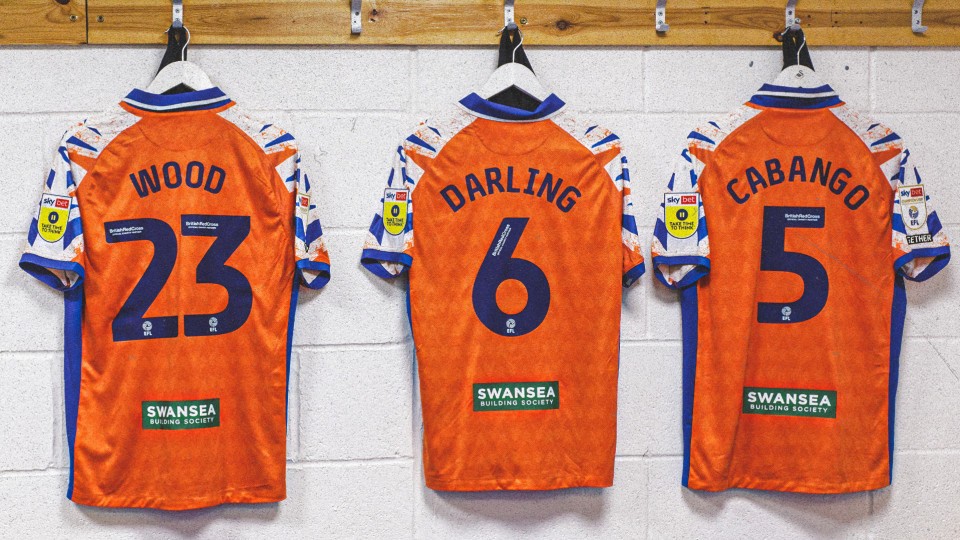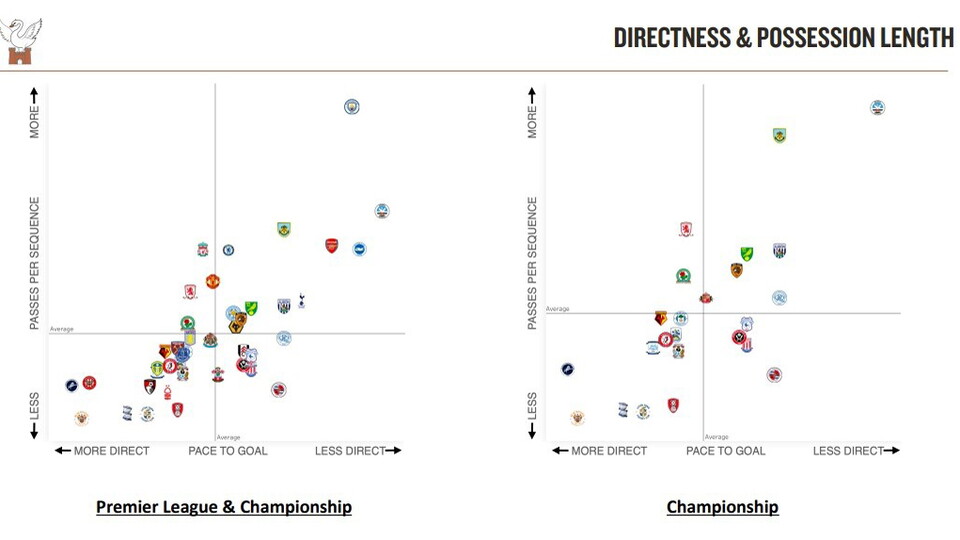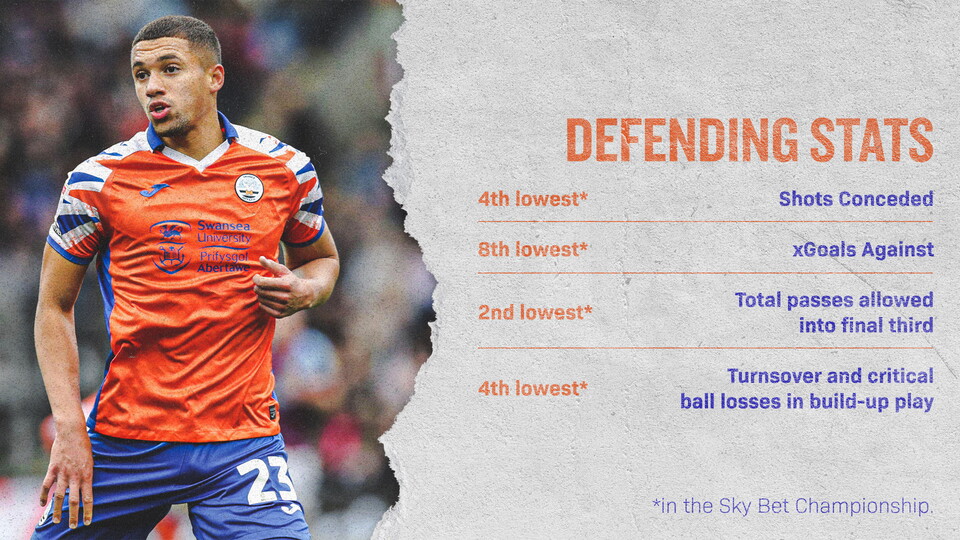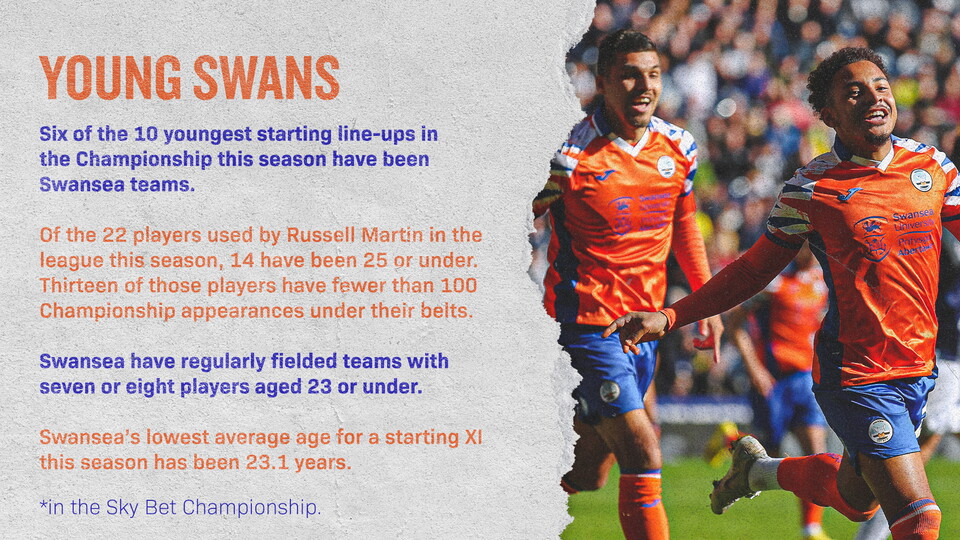Vital Statistics ahead of the Championship run-in

It is the one word that has been on the lips of nearly everyone connected with Swansea City over recent weeks: Frustration.
It is an emotion that is not easy to shake, and it is also one that has the ability to pick away at the very essence of what you hope for, what you work for and what you believe in.
Head coach Russell Martin has twice spoken eloquently on the subject within the last couple of weeks.
Firstly, following the conclusion of a transfer window in which no additions were made to the playing squad and, secondly, following Wednesday night’s win over Blackpool at the Swansea.com Stadium.
His message was clear and impassioned. We are at a stage where everyone has to be able to park that sense of frustration and come together for the final stages of what has been a challenging 2022-23 campaign.
A young squad remains in with a puncher’s chance of coming through a crowded field to secure a play-off place, Swansea are five points adrift of the top six and have an opportunity to find the sort of form that catapulted them up the table during the autumn. It has been done once already this season, there is no reason it cannot happen again.
Not that Martin himself has tried to pretend he has not felt those frustrations, indeed captain Matt Grimes also spoke openly about his own feelings when facing the media ahead of the game at Sheffield United.
But Swansea remain in the play-off hunt, albeit the task is not an easy one. Outside of the top two the Championship is as fiendishly difficult to predict and work out as ever.
The Swans are back in the top half of the table following the midweek round of games, but the underlying evidence strongly suggests this is a team who can be in those top six places come the evening of the first bank holiday in May.

Swansea’s playing identity under Martin – as has been the case under a number of managers since the appointment of Roberto Martinez back in 2007 – is possession-based. They dominate the ball like no other side in the Championship.
It can be made to look easy, but it takes tremendous hard work, detail and accuracy to carry off effectively with and without the ball, as Swansea’s high possession figures are also an indicator of how well they press off the ball to get it back quickly.
No side in the Championship enjoys more of the ball or completes more passes than the Swans, but we won’t dwell on this on this occasion as it’s a fact the majority of you will be more than familiar with.
But that style of play has its critics, not that it will come as a surprise to fans who have seen it questioned or written off by those outside SA1 on a number of occasions over the last decade and more.
Some view it as possession for possession’s sake, but any team who has the ball as much as Swansea will inevitably need to go backwards and sideways at times.
Against deep lying teams, that ability to reset, make the pitch bigger and draw defenders away from their own box is an important tool. It could be seen in the opening goal against Blackpool where Swansea briefly went back to their defence to draw players out and open up the space for a sweeping attack.
However, the notion that Swansea do not play the ball forward, or are simply not creative in what they do in possession, is completely wrong. For all attacking parameters they are in the top handful of teams in the Championship.
Below are some of Swansea’s figures at the end of January, and where it ranks in the second tier.
- Possession – 1st
- Successful Passes – 1st
- Successful Forward Passes – 1st
- Successful Passes Into the Final Third – 1st
- Touches in the Opposition Box – 4th
- Total shots per 90 minutes – 6th
- Chances created – 6th
- Expected Goals – 4th (During February Swansea have risen to 3rd)
- Total Goals Scored – 5th
A quick look at those figures tells you that with the ball, Swansea City are a play-off team. They are in the top six for every one of those metrics over the first six months of the season. It’s a large sample size, it’s not pulled from a handful of games. Over the season, with the ball and when attacking, Swansea are one of the most effective sides in the second tier.
In terms of goals scored, supporters will not need reminding that the current figure of 45 from 31 games could easily be considerably higher given the chances created and spurned.
When you take into account both Premier League and Championship teams, Swansea are second behind Manchester City with Burnley in third when it comes to passes per possession sequence. Those two teams are top of their respective divisions at the time of writing.
They are third across the Premier League and Championship for deep progressions – the movement or carrying of the ball into the final third – with only Manchester City and Liverpool having higher tallies.
Renowned pressing, possession-based sides Burnley, Liverpool, Arsenal, Chelsea and Brighton make up the rest of the top seven.
They are well clear of all other Championship sides.

Bypassed players
Another area where Swansea’s ability to operate effectively in possession is in terms of opponents bypassed. This data – provided by Impect - measures the number of opponents taken out of the game by a pass or run.
Given the importance of finding spaces between the defensive lines to Swansea’s game, it’s an important indicator and they are top of the Championship when it comes to such actions.
Indeed, captain Matt Grimes, the heartbeat of this Swansea side, has played more forward line-breaking passes this season than any other Championship player. In fact, his tally is also higher than any player in the top five European leagues, too.
At the end of January Swansea’s total figure of bypassed opponents stood at 297, with only leaders Burnley, another possession-based team, anywhere near that tally, which has since climbed to over 300.
Last season only Fulham could beat Swansea’s tally. This term, the Swans are almost level with last season’s total with a third of this season remaining.
But Swansea’s bypassed defenders tally is in the mid-table range, and this is largely due to Martin’s team often facing sides happy to sit deep and pack numbers behind the ball.
Additionally, the difference between the highest and lowest in the Championship is just 16 defenders, so the overall opponents passed figure is a better reflection of the overall trends.

Without the ball
So, there will be those who choose to look at all that and simply say that none of it matters. What matters is the scoreline.
It’s true, you don’t get points for possession or forward passes, but the reason to outline these statistics is that they are central to Swansea’s identity and gameplan.
Teams can play brilliantly and lose, teams can play poorly and win. That’s the nature of sport, and it’s the reason so many coaches talk about performance over result. The outcome does not always tell you the full story of whether a team is progressing or developing.
Martin has said on a number of occasions there have been performances in defeat where he has been happier than with the showings in victory, even though all successes are to be enjoyed.
But, if everything is based on outcome, then how do you adapt a consistent and long-term approach to how to play the game?
Supporters will not need reminding that one of the reasons Swansea are in the Championship in the first place is a loss of playing identity. The outcome became everything.
An identity allows for clarity for players, coaches and beyond. If you know what your team should look like, then you can understand what the next steps are in developing and improving.
So, why aren’t Swansea in the play-off places if all their attacking stats suggest they are a top-six side?
Consider the below stats (as of January 31) and how they don’t correlate:
- Shots conceded – 4th lowest in the Championship
- Expected goals against – 8th lowest in the Championship
- Total passes allowed into final third – 2nd lowest in the Championship
- Turnovers and critical ball losses in build-up play – 4th lowest in the Championship. (Only six more players on AVG per 90 taken out of the game from ball losses than the lowest team)
- Goals conceded – 4th highest in the Championship (level with Reading).
This comes back to the biggest bugbear for coaching staff and players alike. Swansea are among the Championship’s leading scorers, most stats tell us they allow fewer opportunities than the majority of teams in the division; but have a goal difference at the time of writing of -1.
Swansea score highly for being among the most defensively compact sides in the Championship, no team has allowed fewer players to be bypassed by an offensive action from the opposition.
It comes down to individual and collective errors in certain moments, it comes down to the nature of the opportunities those errors present to opponents, and there can be no denying they have played a key part in the narrative of Swansea’s season.
Supporters will be able to pick out games and moments fitting a pattern that – and here’s that word again – provided so much frustration for all concerned.
Because logic tells you that any team that creates a high number of chances and allows very few, must be a good side. But key moments and mistakes have proved so, so costly for Swansea.
It has been the difference, there is no shying away from it, and it’s not as simple as blaming defenders and goalkeepers because those momentary lapses have at times been collective as much as individual. In a team sport, responsibility is shared.
It’s an area Martin and his squad have acknowledged and need to improve, and learning those lessons taps in to another aspect of Swansea’s squad that once again reflects well on the efforts of the head coach and his players.

Young players
Again, much like the possession figures outlined earlier in this piece, supporters will be aware of how young this Swansea squad is.
But, just to underline that point in clear terms, consider the following:
- Six of the 10 youngest starting line-ups in the Championship this season have been Swansea teams. Only Sunderland come close to that figure.
- Of the 22 players used by Russell Martin in the league this season, 14 have been 25 or under.
- Of those 22, three of those players left the club on loan during January, while Morgan Whittaker was recalled from his loan spell.
- 13 of those players have fewer than 100 Championship appearances under their belts.
- Swansea have regularly fielded teams with seven or eight players aged 23 or under.
- Swansea’s lowest average age for a starting XI this season has been 23.1 years. Second-placed Sheffield United have occasionally fielded teams with an average age of 29.7 years.
- The average age of Swansea’s 2011 play-off winning side was 26.2 years, with only four players aged 23 or under.
So, as anyone working in any field will know, when you are at the start of your career or profession you inevitably make mistakes as you learn.
That progress is never linear, it is never a straight line on a graph that steadily and continually rises up over time.
You improve in some areas, but others take time. Some mistakes you quickly eradicate, others take longer to iron out.
It is no different with young players. As Martin himself has said, young players will have tough moments. It is part of their development and it has to be not just accepted, but understood as part of any process.
That is why Martin has called for everyone to unite behind this young group, they need support from all quarters because they will have difficult periods and tough times. Fortunately they have always had the tremendous backing of the home and away support of the Jack Army firmly behind them.
So many have shown what they are capable of. Look at the likes of Ben Cabango, Ollie Cooper, Nathan Wood, Luke Cundle and Joel Piroe. The talent is there, but it needs nurturing and continual development to help this squad go on and achieve what everyone connected with Swansea City so desperately wants it to achieve.

Conclusion
Recently, Opta assessed all the teams in the Championship statistically and used all that information to pull together a league table.
In that table, Swansea were fourth in the Championship on expected points related to how they have performed in games. Their goal difference in that equation was plus 10.
That just underlines where Swansea could, and even perhaps should, be. Frustrating for everyone? Yes.
But the season is not over, there are 15 games to go and just five points separating the Swans from the top six.
At this same stage of the 2019-20 season, the Swans were four points off the top six and we all know how that ended up.
It may well be that this piece is a long way of telling you what you already know. Swansea are close, very close, to being the team everyone can see Martin and his staff are trying to build in SA1.
The foundation stones are in place which is underlined by this weekend’s fixture at Blackburn. Swansea last went there in Martin’s first game in charge, consider the progress made between then and now.
There is work to be done, and there will be work to be done regardless of how the remainder of the season plays out.
But Swansea remain in the hunt. They are underdogs undoubtedly, operating on a budget in the lower third in the division and on the back of a January where no additions were made to the squad.
Yet this young group of players has already overcome the odds to be statistically among the best teams in the Championship across a number of parameters, and to be a play-off contender despite the setbacks they have faced.
It’s a different way of doing things, and plenty of naysayers will be doubtful, but that has never bothered a club that has always thrived on being different and believing in its identity.